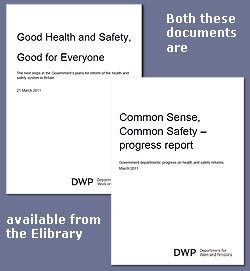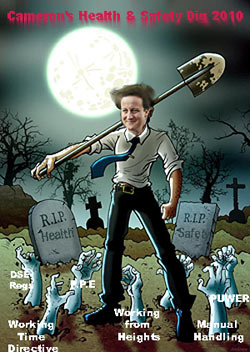 |
 |
|
Government Announces Removal Of health And Safety Protection From Most Workplaces Two days prior to the budget announcement this week, which included confirmation of the Tory’s attacks on health and safety and the rights of workers in the UK, the minister for H&S issued further details of the deregulation of health and safety which heralds the introduction of the American system of non-prevention of injuries and death in the workplace.
“Sensible health and safety at work helps to maintain a healthy and productive workforce and contributes to economic prosperity. “The burden of health and safety red tape has, however, become too great, with too many inspections of relatively low risk and well-performing workplaces, frequent, poor health and safety advice to businesses from badly qualified consultants, and a complex structure for regulation." Chris Grayling's report entitled, Good Health and Safety, Good for Everyone, goes into detail of how the government will decimate health and safety legislation and remove it from most of the UK’s working environments. It follows the principle of ‘wait until something happens, then take minimum action’ whilst at the same time changes to regulations around compensation for death or injury at work will make it much harder and far more costly for anyone to take court action in the event of their injury. Simply put, the result will be injury followed by dismissal, followed by the company getting clean away with it. The document makes all this clear in a major section entitled, The New Health and Safety Framework, which states: The Government has identified three categorizations of non-major hazard industries:
The categorizations set out above will inevitably change in their composition over time e.g. as an industrial sector improves its health and safety record, or as new industries with new health and safety challenges emerge. However, based on current analysis, the categorizations would result in the following groupings:
An associated progress report was also issued at the same time, and reading both documents together shows the true nature of the attacks on health and safety in the UK. IOSH issued a press release broadly welcoming the Government's aims, with the headline: Health and safety body welcomes Government's "new start" IOSH Policy and Technical Director Richard Jones, is quoted as saying: “We welcome the positives in the Government announcement, as well as the opportunity to continue to be part of the solution. It’s great that the Government recognises the value of good health and safety advice for productive workforces and economic prosperity.” However, he did not agree with everything in the document: “We’re concerned that inspections are to be cut, because enforcement is an important motivator for companies to provide essential worker and public protection. We’d like reassurance that the more hazardous industries like construction, agriculture and manufacturing, will receive advice and enforcement levels proportionate to the risk and work-related deaths, injuries and illnesses that they suffer.” IOSH support for the governments attacks in current health and safety legislation and practice will be seen by those concerned for the future of the UK workforce's health safety and welfare, as simply naive. Whilst the document will be seen by many as presenting reasonable aims in its introduction, the reality is that once again the Tories use double-speak to hide their real intentions. The TUC March for the Alternative on 26th of this month will be a public display of the Trade Union movement's response to the Con-Dem(ned) government plans for health and safety. There are many who believe that by the time the country wakes up to the reality of health and safety de-regulations, hundreds more will be injured, thousands more will suffer from even greater levels of work related stress, and many more deaths at work will occur. Just who is, Professor Ragnar Löfstedt, the Government's independent advisor on the new health and safety framework? See here Source: DWP / IOSH
|

 The full document was issued and published on the DWP website, but interestingly no major press release was issued by the DWP to the public.
The full document was issued and published on the DWP website, but interestingly no major press release was issued by the DWP to the public.